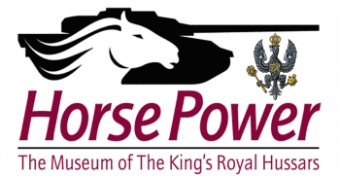Regimental Brooches
As Valentine’s Day has just passed it is a perfect time to showcase a few of the brooches from our new display at HorsePower, and look at the origins of the regimental sweetheart brooch.
The fashion of wearing regimental brooches can be traced back to Lady Airlie, the wife of David Ogilvy, the 11th (and 6th) Earl of Airlie. The Earl of Airlie served in the 10th Royal Hussars between 1875 – 1897. In 1886 he married Mabell Frances Elizabeth Gore and commissioned a replica of the cap badge of the 10th Royal Hussars specially for their wedding.
In her memoirs ‘Thatched with Gold’ Lady Airlie credits wearing the brooch with beginning a trend that continues today:
‘I wore the brooch given me by David – the badge of the 10th Royal Hussars in diamonds. He had had it specially designed for me and thus I was the first woman to wear a regimental badge. As I was rarely seen without it after our marriage, other Army wives copied me and a new fashion in jewellery was [started]’. (Thatched With Gold, The Memoirs of Mabell Countess of Airlie)
In 1900 the Earl was killed leading the 12th Lancers at the Battle of Diamond Hill. The Airlie Brooch, as it is now known, is on loan to the King’s Royal Hussars from the Airlie family and is worn by the Commanding Officer’s wife, nearly 150 years after it was made. A similar brooch is worn by the Adjutant’s wife.
During the First World War, the demand for Regimental or ‘sweetheart’ brooches rapidly increased. They were produced in a variety of materials and purchased by all ranks to give to loved ones.
Below we look at a few of the brooches on display and the background behind them:


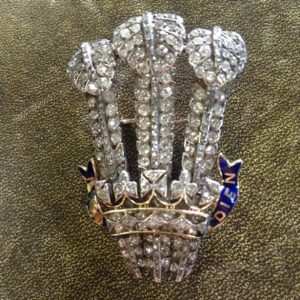
Royal Hussars brooch given to HRH Princess Alice
This diamond brooch was commissioned for Princess Alice, Duchess of Gloucester, and presented to her on the amalgamation of the 10th and 11th Hussars to form The Royal Hussars in 1969.
She was the only Colonel-in-Chief of the RH as she remained Colonel until the formation of The King’s Royal Hussars in 1992.
During the Amalgamation parade at Tidworth, Princess Alice acknowledged the gift in her speech to the Regiment: ‘I would like to thank you all for the lovely brooch I am so proud to wear, and for the beautiful case containing it’.
The brooch was recently presented to the Museum by the current Duke and Duchess of Gloucester, although sadly the original case was not with it!


Princess Alice can be seen wearing the Brooch at the amalgamation in 1969 opposite, with footage from British Pathé.
Princess Alice had a strong personal connection with the Regiment. Her husband, Prince Henry Duke of Gloucester, had served as an officer in the 10th Hussars as had several members of the Montagu Douglas Scott family. During her speech she reflected: ‘I myself feel no stranger amongst you, having had a husband, two brothers, two uncles and a nephew in the 10th Hussars, and many very old and good friends in the 11th’.
The family connection would continue after 1991 when her grandson, Alexander Windsor, Earl of Ulster, commissioned as an officer in the King’s Royal Hussars.
10th Hussars diamond brooch worn by Lady Evelyn Byng
In 1883, Lieutenant The Hon Julian Hedworth George Byng transferred into the 10th Royal Hussars. As the seventh son of the Earl of Stratford his family were initially only able to support a commission in the Militia. However, having been personally offered a place in the 10th by the Prince of Wales the young Byng was determined to join the Regiment and, using his excellent horsemanship, trained polo ponies. This extra income meant he could afford life as an officer in the 10th Hussars.
In 1898 Major Julian Byng met (Marie) Evelyn Moreton. Soon after their meeting he was posted to South Africa for the second Anglo-Boer War. While on campaign he and Eveleyn exchanged increasingly affectionate letters and in January 1902 he proposed adding ‘Would she mind cabling the reply’ she replied ‘Yes Please Return Immediately – Evelyn’. Having been sent from Aldershot the reply reached Byng on the South African veld in eighteen hours. He later had the reply framed and kept it on his desk for the rest of his life!
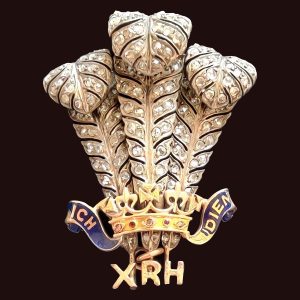
During the war Byng raised and commanded the South African Light Horse and life on campaign with this unconventional unit had resulted in new behaviours as Evelyn recalled: ‘He returned with some odd habits and a strong American accent – for there were many of that nationality among his men- and I remember the first day when we sat in the Crookham drawing-room he casually flung the dregs of his teacup in the fire-to my mother’s speechless horror’.
For their wedding on 30 April 1902 Byng also had 10th Hussar brooches made for all five bridesmaids as the newspapers reported: ‘There were five bridesmaids: Miss Eleanor Brodie, Lady Rachel Byng, Miss Josie Howard, Miss Needham and Miss [Kitty] Boscawen…The bridegroom presented them with bouquets of pink roses, tied with blue ribbons, and the badge of the 10th Hussars in brooches of enamel and diamonds’.
For the first time a military band was allowed to play inside St Paul’s Church Knightsbridge, as the band of the 10th Hussars provided the music whilst NCOs of the Regiment stood by each pew and formed an arch as the bride and groom walked out. The Daily Express commented that there were practically no decorations in the church – the colourful Hussars brightened it enough!
By 1914 Byng commanded 3rd Cavalry Division of the British Expeditionary Force and in 1919 was elevated to the peerage as Baron Byng of Vimy. In 1928 he was made Viscount Byng of Vimy and in 1932 was promoted to Field Marshal.
After the First World War Lord Byng was appointed Governor General of Canada. Worried by his lack of viceregal experience King George V reassured him “You will be just like a king in your kingdom”, to which Byng grinned and replied “Oh no, Sir. More likely I shall just be Byng in my Byngdom”.
Only 3 years after being appointed a Field Marshall, Julian Byng died suddenly at his home on 6 June 1935. Lady Byng died 14 years later on 20 June 1949 at Thorpe Hall, in Essex, England.
Whilst in Canada the couple became avid fans of ice hockey and Lady Byng donated a trophy to the National Hockey League in 1925. Today, the Lady Byng Memorial Trophy is awarded to the player showing the greatest sportsmanship throughout the season.

11th Hussars brooches bought by Oliver Wentworth-Stanley MC


These two 11th Hussar silver and diamond brooches are believed to have been bought by Major Oliver Wentworth-Stanley MC. The left is the cap badge of the Regiment while on the right is a cypher of the 11th Hussars, usually used on the cross or pouch belt, and uses the letters PAOH for Prince Albert’s Own Hussars.
Oliver Montagu Wentworth-Stanley joined the 11th Hussars in 1941 at the age of 18. He served in North West Europe where his excellence as a Troop leader led to the award of the Military Cross. Wounded, he returned to England and was only fit to re-join his Regiment after the war. He remained with the 11th until 1958, having served in Germany and Malaya. In 1959, just after leaving the Regiment, he married Priscilla Pryor, and the brooches may have been purchased around this time.
On his retirement Major Wentworth-Stanley also presented the 11th Hussars with a complete set of four side drums, fully emblazoned with the Regimental Crest and Battle Honours.
20th Hussars brooch worn by Eleanor Darling
This brooch, the cap badge of the 20th Hussars in gold and enamel set with a sapphire, was commissioned by Captain John Clive Darling of the 20th Hussars for his fiancée Eleanor Joan Powell during the First World War.
John Darling, the son of Charles Darling, 1st Baron Darling, joined the 20th Hussars in 1906.
In 1913 he was promoted to Captain and served throughout the First World War with the 20th Hussars, during which he was wounded, mentioned in despatches, and appointed a Companion of the Distinguished Service Order.
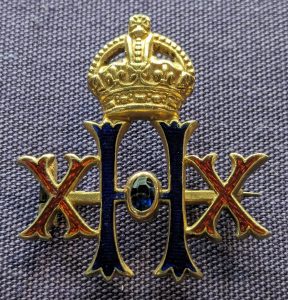
In 1918 he married Eleanor Joan Powell of Wilverley Park of Lyndhurst, who lived not far from Darling’s family home. During the war, Eleanor worked with a Voluntary Aid Detachment (VAD) at Hill House Red Cross Hospital, Lyndhurst, Hampshire, as a House Orderly from August 1916 to July 1918. She was photographed wearing the brooch shortly before her wedding.
The marriage took place at St Michael’s Church, Lyndhurst on 17 August 1918, and was attended by many fellow officers of the 20th Hussars. The couple had two children.
Major Darling was the author of ’20th Hussars in the Great War’. He retired from the Army in 1923 but sadly died aged just 45 in 1933. Their eldest son, Michael, succeeded to his grandfather’s peerage.

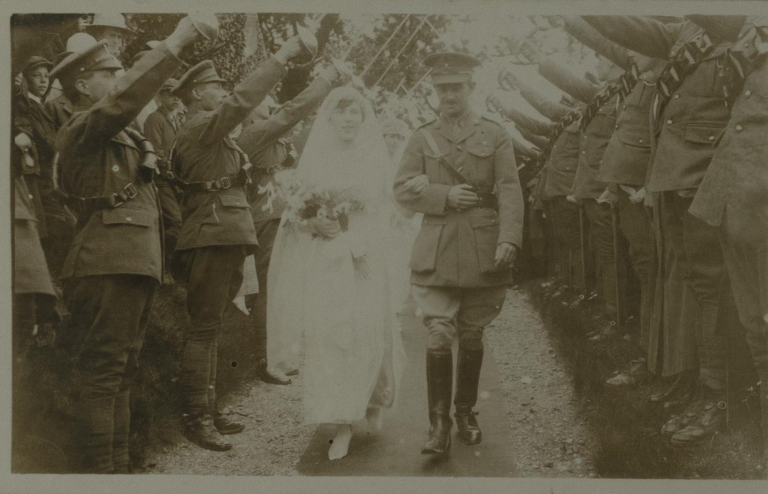
We hope you have enjoyed this month’s article. The small display of brooches was an opportunity to showcase a few of the magnificent examples in the collection which have rarely been on display. It was put together with the help of Museum Trustee and volunteer, Christine Beresford, and many visitors have commented on the ‘sparkle’ it has added. Photographs alone do not do the brooches justice, so it is well worth visiting HorsePower to see them at their best!
